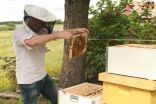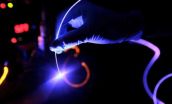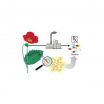(Press-News.org) ITHACA, N.Y. – Robo Brain – a large-scale computational system that learns from publicly available Internet resources – is currently downloading and processing about 1 billion images, 120,000 YouTube videos, and 100 million how-to documents and appliance manuals. The information is being translated and stored in a robot-friendly format that robots will be able to draw on when they need it.
To serve as helpers in our homes, offices and factories, robots will need to understand how the world works and how the humans around them behave. Robotics researchers have been teaching them these things one at a time: How to find your keys, pour a drink, put away dishes, and when not to interrupt two people having a conversation.
This will all come in one package with Robo Brain.
"Our laptops and cell phones have access to all the information we want. If a robot encounters a situation it hasn't seen before it can query Robo Brain in the cloud," said Ashutosh Saxena, assistant professor of computer science at Cornell University. Saxena and colleagues at Cornell, Stanford and Brown universities and the University of California, Berkeley, say Robo Brain will process images to pick out the objects in them, and by connecting images and video with text, it will learn to recognize objects and how they are used, along with human language and behavior.
If a robot sees a coffee mug, it can learn from Robo Brain not only that it's a coffee mug, but also that liquids can be poured into or out of it, that it can be grasped by the handle, and that it must be carried upright when it is full, as opposed to when it is being carried from the dishwasher to the cupboard.
Saxena described the project at the 2014 Robotics: Science and Systems Conference, July 12-16 in Berkeley, and has launched a website for the project at http://robobrain.me
The system employs what computer scientists call "structured deep learning," where information is stored in many levels of abstraction. An easy chair is a member of the class of chairs, and going up another level, chairs are furniture. Robo Brain knows that chairs are something you can sit on, but that a human can also sit on a stool, a bench or the lawn.
A robot's computer brain stores what it has learned in a form mathematicians call a Markov model, which can be represented graphically as a set of points connected by lines (formally called nodes and edges). The nodes could represent objects, actions or parts of an image, and each one is assigned a probability – how much you can vary it and still be correct. In searching for knowledge, a robot's brain makes its own chain and looks for one in the knowledge base that matches within those limits. "The Robo Brain will look like a gigantic, branching graph with abilities for multi-dimensional queries," said Aditya Jami, a visiting researcher art Cornell, who designed the large-scale database for the brain. Perhaps something that looks like a chart of relationships between Facebook friends, but more on the scale of the Milky Way Galaxy.
Like a human learner, Robo Brain will have teachers, thanks to crowdsourcing. The Robo Brain website will display things the brain has learned, and visitors will be able to make additions and corrections.
INFORMATION:
The project is supported by the National Science Foundation, The Office of Naval Research, the Army Research Office, Google, Microsoft, Qualcomm, the Alfred P. Sloan Foundation and the National Robotics Initiative, whose goal is to advance robotics to help make the United States competitive in the world economy.
Cornell University has television, ISDN and dedicated Skype/Google+ Hangout studios available for media interviews.
'Robo Brain' will teach robots everything from the Internet
2014-08-25
ELSE PRESS RELEASES FROM THIS DATE:
Train your heart to protect your mind
2014-08-25
Exercising to improve our cardiovascular strength may protect us from cognitive impairment as we age, according to a new study by researchers at the University of Montreal and its affiliated Institut universitaire de gératrie de Montréal Research Centre. "Our body's arteries stiffen with age, and the vessel hardening is believed to begin in the aorta, the main vessel coming out of the heart, before reaching the brain. Indeed, the hardening may contribute to cognitive changes that occur during a similar time frame," explained Claudine Gauthier, first author of the study. ...
Study suggests repurposing anti-depressant medication to target medulloblastoma
2014-08-24
CINCINNATI – An international research team reports in Nature Medicine a novel molecular pathway that causes an aggressive form of medulloblastoma, and suggests repurposing an anti-depressant medication to target the new pathway may help combat one of the most common brain cancers in children.
The multi-institutional group, led by scientists at Cancer and Blood Diseases Institute (CBDI) at Cincinnati Children's Hospital Medical Center, publish their results in the journal's online edition on Aug. 24. The researchers suggest their laboratory findings in mouse models of ...
Evolutionary history of honeybees revealed by genomics
2014-08-24
In a study published in Nature Genetics, researchers from Uppsala University present the first global analysis of genome variation in honeybees. The findings show a surprisingly high level of genetic diversity in honeybees, and indicate that the species most probably originates from Asia, and not from Africa as previously thought.
The honeybee (Apis mellifera) is of crucial importance for humanity. One third of our food is dependent on the pollination of fruits, nuts and vegetables by bees and other insects. Extensive losses of honeybee colonies in recent years are a ...
Signatures of selection inscribed on poplar genomes
2014-08-24
One aspect of the climate change models researchers have been developing looks at how plant ranges might shift, and how factors such as temperature, water availability, and light levels might come into play. Forests creeping steadily north and becoming established in the thawing Arctic is just one of the predicted effects of rising global temperatures.
A recent study published online August 24, 2014 in Nature Genetics offers a more in-depth, population-based approach to identifying such mechanisms for adaptation, and describes a method that could be harnessed for developing ...
Mimicking natural evolution with 'promiscuous reactions' to improve the diversity of drugs
2014-08-24
A revolutionary new scientific method developed at the University of Leeds will improve the diversity of 'biologically active molecules', such as antibiotics and anti-cancer agents.
The researchers, who report their findings online today in the journal Nature Chemistry, took their inspiration from evolution in nature. The research may uncover new pharmaceutical drugs that traditional methods would never have found.
"Nature produces some amazing structures with really interesting biological activity, but the plant or animal did not design them. Instead the organisms ...
Study: Cutting emissions pays for itself
2014-08-24
CAMBRIDGE, Mass-- Lower rates of asthma and other health problems are frequently cited as benefits of policies aimed at cutting carbon emissions from sources like power plants and vehicles, because these policies also lead to reductions in other harmful types of air pollution.
But just how large are the health benefits of cleaner air in comparison to the costs of reducing carbon emissions? MIT researchers looked at three policies achieving the same reductions in the U.S., and found that the savings on health care spending and other costs related to illness can be big ...
Driving brain rhythm makes mice more sensitive to touch
2014-08-24
PROVIDENCE, R.I. [Brown University] — By striking up the right rhythm in the right brain region at the right time, Brown University neuroscientists report in Nature Neuroscience that they managed to endow mice with greater touch sensitivity than other mice, making hard-to-perceive vibrations suddenly more vivid to them.
The findings offer the first direct evidence that "gamma" brainwaves in the cortex affect perception and attention. With only correlations and associations as evidence before, neuroscientists have argued for years about whether gamma has an important role ...
Are you as old as what you eat? Researchers learn how to rejuvenate aging immune cells
2014-08-24
Researchers from UCL (University College London) have demonstrated how an interplay between nutrition, metabolism and immunity is involved in the process of ageing.
The two new studies, supported by the Biotechnology and Biological Sciences Research Council (BBSRC), could help to enhance our immunity to disease through dietary intervention and help make existing immune system therapies more effective.
As we age our immune systems decline. Older people suffer from increased incidence and severity of both infections and cancer. In addition, vaccination becomes less efficient ...
Stanford bioengineers close to brewing opioid painkillers without using opium from poppies
2014-08-24
For centuries poppy plants have been grown to provide opium, the compound from which morphine and other important medicines such as oxycodone are derived.
Now bioengineers at Stanford have hacked the DNA of yeast, reprograming these simple cells to make opioid-based medicines via a sophisticated extension of the basic brewing process that makes beer.
Led by Associate Professor of Bioengineering Christina Smolke, the Stanford team has already spent a decade genetically engineering yeast cells to reproduce the biochemistry of poppies with the ultimate goal of producing ...
'Haven't my neurons seen this before?'
2014-08-24
PITTSBURGH—The world grows increasingly more chaotic year after year, and our brains are constantly bombarded with images. A new study from Center for the Neural Basis of Cognition (CNBC), a joint project between Carnegie Mellon University and the University of Pittsburgh, reveals how neurons in the part of the brain responsible for recognizing objects respond to being shown a barrage of images. The study is published online by Nature Neuroscience.
The CNBC researchers showed animal subjects a rapid succession of images, some that were new, and some that the subjects ...



